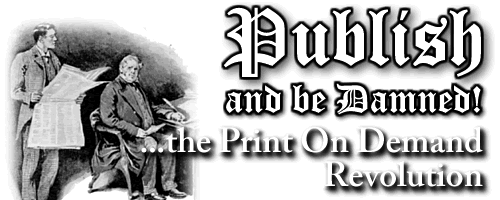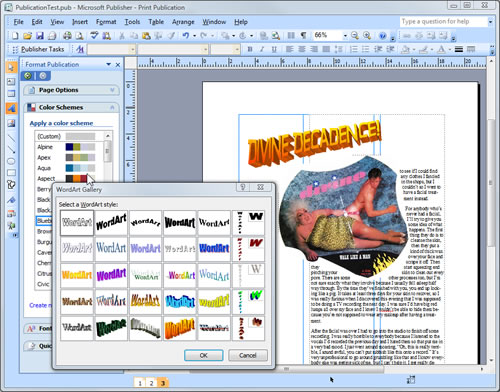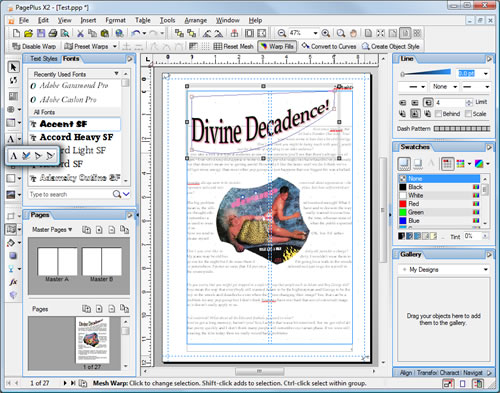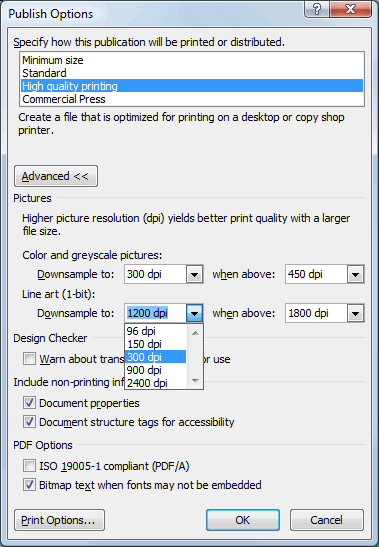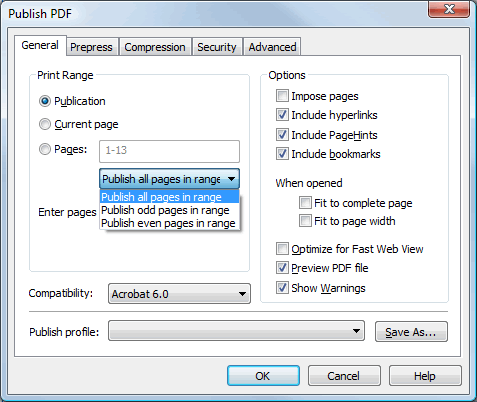[ Go back to normal view ]
BW2 :: the bitwise supplement :: http://www.bitwisemag.com/2
Publish And Be Damned!
or: How Lulu Made Me a POD Person...2 September 2007
by Huw Collingbourne
There was a time when, in order to be a published author, you either had to: a) have been to the right school and joined all the right societies or b) be a personal friend of a publisher (where steps (a) and (b) are not mutually exclusive). In a few rare cases you might even have made it in talent alone.
These days, the budding author need no longer suffer frustrating years spent papering the walls of a rat-infested garret with rejection slips from literary agents and publishers. If you want to get your book published, you can do it yourself. All it takes is hard work, determination and (ideally though not necessarily) a spark or two of talent.
The really, really good news is that it doesn’t even require any money. Well, unless you count the cost of your time, that is. If you use the print on demand (POD) publisher, Lulu, you can upload the final copy of your book at no cost. You only pay Lulu when the book sells – that is, for each copy sold, the publisher takes a slice and you take the rest (for the actual maths of that see the link to Lulu Royalty Calculator at the end of this article).
Bitter Experience
Having run a magazine publishing business for a while, I can tell you that the knowledge that I won’t have to pay any bills up front was the first thing that attracted me to Lulu. When you publish magazines or books the ‘conventional’ way you have to stump up your hard earned cash – typically several thousand dollars, pounds or Euros of the stuff – before you can so much see one single page rolling off the presses. Moreover, you have to commit yourself to printing a fixed number of books or magazines, each and every one of which you pay for, in the expectation that this is the exact number you will be able to sell. Those that remain unsold are money down the drain. I know – been there, done that and my drains are stuffed with paper...
The advantages of self publishing are not merely financial, however. There is also the ‘creative advantage’. As you are in full control of the entire publishing process you don’t have to worry that your words will be mangled by some illiterate editor; or that your sensitive book about love and loss among the fishing communities of the Outer Hebrides will be tarnished by a sensationalist cover showing a semi-naked femme-fatale clasping a bloodstained fish-hook; or that (worst of all) the entire publishing world will be so ignorant of the merits of your literary efforts that you can’t even get a place in the ‘slush pile’ (the heap of unloved manuscripts which, according to legend, book publishers keep in the corner of their office in the hope that, one rainy day, when they have nothing better to do, they will delve into the pile and pull out the next Hemmingway, Capote or – joy of joys! – J K Rowling...)
There are downsides too. In the absence of an editor, you have to do all your own proofreading, in the absence of a cover designer, you have to create your own artwork and, in the absence of a marketing department or distribution service, you also have to find a way to let the world know that your book exists and also give them some place where they can buy it.
But before getting down to the nitty-gritty details of all that, you first have to find yourself a POD publisher to print your book. I’ve already mentioned Lulu, but there are some other POD publishers around too. And over the next few years, I imagine that more will appear. The following are probably the three best known, currently:
BookSurge: http://www.booksurge.com/
Blurb: http://www.blurb.com/
Lulu: http://www.lulu.com/
BookSurge is owned by Amazon. The company provides a number of publishing options which, however, do require some cash up front. The cheapest option, as far as I can se, is the ‘Author’s Express PDF’ package which requires that you submit a black and white book in PDF format and pay $99 for the privilege. This may be followed by other options to promote the work (at additional cost). There are all kinds of other options, some of which include professional assistance (for example, having your book edited or having your cover designed) but many of these options weigh in at a pretty hefty price ($3,600 for ‘comprehensive copy editing’, for example). After scouring their site, I am still not entirely clear how much it will cost to get my book printed and distributed. I may be doing BookSurge an injustice, but this service looks pretty expensive and, what’s more, darn’ confusing. If you can make head or tail of all options on their site, you are doing better than me...
Blurb struck me as a much more interesting alternative. This aims to take the guesswork out of book production (how do you set up the paper, the margins, the fonts etc. and how do you generate a ‘publication-ready’ manuscript?) by supplying some free, DTP software (Windows only) aimed specifically at creating publications for Blurb. They only offer a small range of book sizes, however, and don’t currently have an ISBN allocation service (ISBNs are the numbers and bar codes on books – you need them to sell in bookstores or online bookshops), though they say they will have this service soon. The pricing per book does seem a bit high, though.
Lulu is the best known POD publisher and, judging by the sheer size of their web site and the number of books on sale there, it looks as though they are doing brisk business these days. They can print black and white or colour books, they have an optional ISBN service and can arrange distribution via Amazon and Barnes and Noble. They offer printing in a variety of formats (though not, curiously, the most popular size for computer books – namely 7” wide by 9” high), and they can also sell your book in the form of PDF downloads. Moreover, they will print and post your books from Europe as well as the US, which significantly reduces the shipping costs to European buyers (currently they charge £1.50 – about $3.00 - to ship a book to the UK). Lulu really seems to be the driving force behind POD at the moment and, for my own projects, this is the company I’ve decided to use.
Yes, I really am putting POD to the test myself. I am currently working on two books – one is a programming book of about 400 pages in length; the other, around 100 pages, is an illustrated collection of interview with pop stars from the 1980s (interviewing pop stars being the nearest I got to gainful employment in my younger days... ) Naturally, before you can even think about publishing a book, you need to have written one. And, having written it, you need have formatted it for printing. Some POD services accept text in word processing formats. For complete control over the formatting, however, PDF format is preferable. When it is formatted it as PDF the final printed book should be identical – or, anyway, very close – to the PDF file that you submitted.
WP or DTP...?
In order to do the formatting, you have to decide on which program you will use for the task. As you have no doubt written the book using a word processor, it may seem natural to format it using the same word processor. That’s fine if the book has a relatively simple layout – such as a novel, for example. It’s probably not the best solution for a book with a complex layout – such as an illustrated guide to Ming Dynasty vases, say, or a collection of interviews with pop stars of the 1980s...
Word is fine for relatively simple book layouts For complex layouts, a Desktop Publishing (DTP) program is the better choice. Not only does a DTP program provide you with far more control than a word processor over the fine details of layout and graphics, but it also makes it natural to organize a book as separate ‘features’ or ‘chapters’ (in DTP jargon, ‘stories’) each of which can be ‘flowed’ from one frame to the next, arranged in full pages or aligned in columns, trickled around embedded images and so on.
But where does this leave you if you have written a book with a more complex layout than a novel (such as a programming book with its blocks of code and boxouts) but less complex than a lavishly illustrated book? In principle, a DTP program would be the better choice in terms of the fine control it would give you; but balanced against this is the amount of time it would take to arrange the layout of many hundreds of individual pages. I personally decided that the time considerations outweighed the aesthetic ones. My own programming book is, therefore, being formatted using Microsoft Word (the free OpenOffice word processor would be another possibility – usefully this as PDF export built in).
Doing the formatting with Word has, in fact, taken longer than I was anticipating. The first thing I did was put each chapter into its own ‘section’ (Page Layout, Breaks, Section Breaks/Next Page in Word 2007). One of the advantages of doing this is that it lets me put the name of each chapter into the header (hint: this is done by creating a Heading Style for each chapter and inserting its ‘StyleRef’ into the header. In Word 2007 select Insert, QuickParts, Field and choose StyleRef. For example, my chapter titles have the “Heading1,Heading” style and the StyleRef field in my headers is, consequently:
{STYLEREF "Heading1,Heading" \*MERGEFORMAT}). I have also had to get to grips with other areas of Word which I have hitherto never used such as its hyphenation (which is adequate but not great) and its indexing (which is astonishingly tedious). If I were a regular DTP user, I would undoubtedly have gone down the DTP route for this book. As I am not, I reckon Word gives me about 95% of the effect for about 50% of the effort, which seems a reasonable compromise.DTP Or Not DTP?
But let’s say you have decided that DTP is the right choice for you (as I did for my ‘80s book).What are the choices available? DTP professionals will tell you that their favourite program – probably either Quark XPress or Adobe InDesign – is the tool for the job. Unfortunately, these programs have two drawbacks for the non-professional: 1) in the initial stages, they are hard to learn to use (I know, I’ve tried); 2) and this is the killer – they are ferociously expensive: (each costs somewhere between $700 and $800).
So what is available to those of us who want an easier and cheaper path to a professional quality publication? My two top choices would be Microsoft Publisher and Serif PagePlus.
The main benefit of Microsoft Publisher is simplicity and its familiar user interface. Microsoft Publisher has, in the past, tended to be seen as something of a ‘toy’ application – easy to use, perhaps, but not exactly overburdened with features. In fact, the latest release is a lot more powerful than I’d been expecting. It lets you design master pages as templates for your other pages, it sets up columns automatically and it lets you add graphics and tables. For Word users, though, the thing that really makes it stand out is the familiarity of its environment. This strongly resembles the Word 2003 user interface and is (in my view) much easier to use than the incomprehensible Word 2007 interface. Moreover, MS Publisher also has a very effective Word document importer. One other advantage of Publisher is that you may already have it. Publisher is supplied as a standard part of some versions of Microsoft Office 2007. Bear in mind that while it can save PDF, in order to do so you have to download and install a separate (free) add-on from the Microsoft site. Its PDF generation is adequate for most purposes but doesn’t offer a great deal of control over the process.
Serif PagePlus is much more like a high-end DTP package - in spite of its price. Serif PagePlus will, for most Word users, take a bit more time to get to grips with. Its user interface has more in common with high-end DTP packages than with Word, and its broad range of tools, dialogs, panels and windows may initially seem overwhelming. On the plus side, this is an extraordinarily capable program at the price. In short, its resemblance to high-end packages is not merely ‘skin deep’ – there is real substance there. PagePlus lets you create one or more sets of ‘master pages’ which can be selected as templates for other pages; you can flow text around graphics, even into the indentations of irregular shapes (this is done much more effectively than in MS Publisher), you can import PDF documents (it converts them to editable text) and export your entire publication as PDF (its PDF exporter is pretty impressive, in fact); it also has a good range of word processing features such as mail-merge, spelling checker and thesaurus. There are one or two deficiencies, however. Its automatic formatting of offset page margins (that is, the margins based on left and right-hand master pages) may in some circumstances, go awry. And its Word 2007 document importer is a good deal clunkier than the MS Publisher equivalent. I’ve reported both these issues to Serif and am informed that the margin bug will be fixed and the Word importation will be improved in a forthcoming update.
Microsoft Publisher costs about $170 if bought on its own
Microsoft Publisher Web SiteSerif PagePlus X2 costs £99.99 (about $200)
Serif PagePlus Web Site
MS Publisher supplies PDF export as an add-on. It’s pretty effective but doesn’t give you a lot of control.
The Serif PagePlus PDF exporter is a much more complex beast with options spread over multiple tabbed pages. I must admit that my initial temptation for my own publication was to use Microsoft Publisher, simply because of its familiarity. After spending a day or two using Publisher and PagePlus, however, I came to the conclusion that the wealth of features and the amount of ‘fine tuning’ available in PagePlus made it worth the extra learning effort, so PagePlus is the package I chose.
Writing and formatting your book is just the first step of the way, however. I’ll report back later to let you know how I cope with all the other steps to getting myself into print...
Essential Resources
Here are a few of the sites that I have found invaluable in my search for sound information on Print On Demand publishing...
Julian M Bucknall’s Algorithms For The Masses
This site gives an extremely useful account of the whole Lulu-publishing process. Julian is the author of the well respected ‘Tomes Of Delphi’ book, ‘Algorithms and Data Structures’. That book was originally printed and published the conventional way. As the previous version is now out of print, the author decided to get it back into print the Lulu way. In order to do so, he had to go through the entire process of formatting his original manuscript, creating a cover and submitting the final PDF to Lulu. If you are planning to self-publish a technical book, you owe yourself a favour to read this first. In fact, this series of three articles contains useful insights for anyone publishing any sort of POD book.Julian M Bucknall’s Notes On Publishing Using Lulu
Michael Allen’s Grumpy Old Bookman
For advice on the things to do and the things to avoid when selecting fonts and formatting pages, take a read through Page Layout For Beginners blog. If you have no idea what “11.75 point on 15.5 point Minion” is or why the ratios 2:3:4:5 and 2:3:4:6 are special, Allen reveals all...Page Layout For Beginners
LuGaru’s Lulu Royalty Calculators
Work out how much your book will cost to print and how much money you stand to earn. Very important...!
